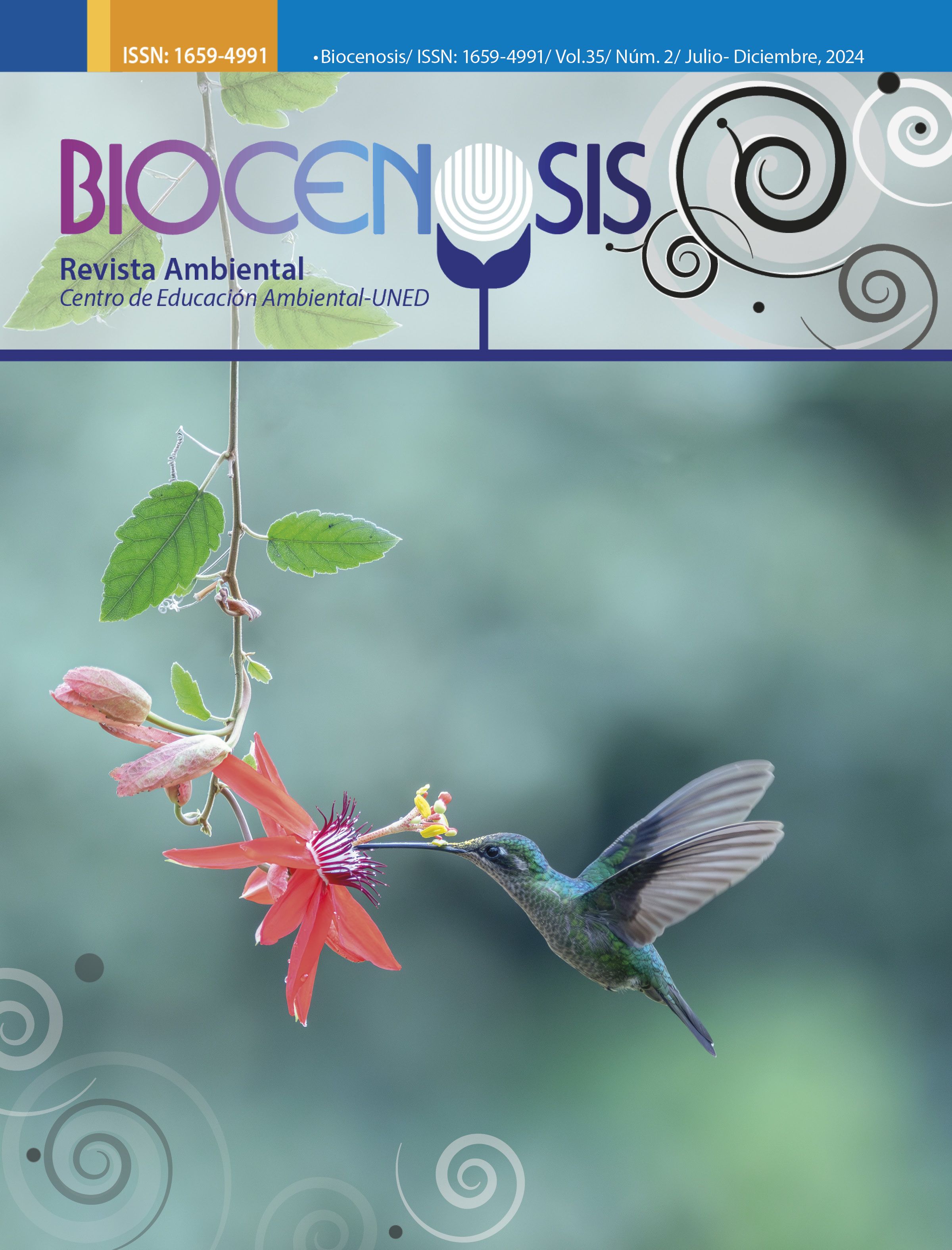Pollinators as a tool for environmental education and awareness in an urban park
DOI:
https://doi.org/10.22458/rb.v35i2.5600Keywords:
biophilia, conservation, environmental interpretation, pollination, interpretive labelingAbstract
The loss of habitats due to deforestation, extensive agriculture, the use of agrochemicals, and urbanization threatens a large number of species around the world. A group that causes concern is the group of pollinators, as a high percentage of the food harvested worldwide directly depends on their intervention. The education and awareness of the general population, through the dissemination of precise and comprehensible scientific information, is key to promoting the protection of pollinators. For this, a scientific outreach strategy was designed, focused on four of the pollinator groups present in the country (bees, birds, butterflies, and bats) and the construction of four specialized pollinator gardens within La Libertad Metropolitan Park, located in the Desamparados canton, Costa Rica. The diversity of pollinator species was determined by conducting observations in the park during the months of September and October 2020. In 2021, a survey was conducted with visitors to assess their level of knowledge and interest in pollinator protection and the Park’s environmental efforts. Based on this data, a strategy was designed to elaborate four gardens, each specialized in a particular pollinator, complete with interpretive labeling.
References
Aguilar Sanz, S. (2016). Evaluación de la eficiencia de las cajas (“ Bee Hotels ”) como herramienta de restauración y rescate de la diversidad de polinizadores. Universidad de Jaén.
Amante, B. L. (2020). La conectividad funcional y los servicios ecosistémicos proporcionados por abejas en los agropaisajes del Corredor Biológico Volcánica Central Talamanca, Costa Rica. In Tesis (Issue 1). Centro Agronómico Tropical de Investigación y Enseñanza (CATIE).
Bawa, K. S. (1990). Plant pollinator interactions in tropical rain forests. Annual Review of Ecology, Evolution, and Systematics, 21(1), 399–422.
Bazán, H. (2013). El mensaje de los paneles interpretativos y el aprovechamiento turístico y educativo del patrimonio natural. Macla: Revista de La Sociedad Española de Mineralogía, 17, 57–58.
Berryman, A. A., Lima Arce, M., Hawkins B. A. (2002). Population regulation, emergent properties, and a requiem for density dependence. Oikos, 99(3), 600-606. https://doi.org/10.1034/j.1600-0706.2002.12106.x
Bhattacharya, A. (1970). Conservation of Pollinator Resources in Botanic Gardens. Our Nature, 8 (1), 332–335. https://doi.org/10.3126/on.v8i1.4341
Cardoso, P., Barton, P. S., Birkhofer, K., Chichorro, F., Deacon, C., Fartmann, T., Fukushima, C. S., Gaigher, R., Habel, J. C., Hallmann, C. A., Hill, M. J., Hochkirch, A., Kwak, M. L., Mammola, S., Ari Noriega, J., Orfinger, A. B., Pedraza, F., Pryke, J. S., Roque, F. O., & Samways, M. J. (2020). Scientists’ warning to humanity on insect extinctions. Biological Conservation, 242 (February). https://doi.org/10.1016/j.biocon.2020.108426
Frick, K. M., Ritchie, A. L., & Krauss, S. L. (2014). Field of Dreams: Restitution of Pollinator Services in Restored Bird-Pollinated Plant Populations. Restoration Ecology, 22(6), 832–840. https://doi.org/10.1111/rec.12152
García Pérez, J. F. (2014). Diagnóstico ambiental del relleno sanitario praderas del Magdalena, Girardot (Cundinamarca) empleando mariposas (Lepidoptera: papilionoidea y hesperioidea) como indicador de tipo y calidad de hábitat. Revista Tumbaga, 1(3), 92–108.
Hernández-Canchola, G., & León-Paniagua, L. (2020). Sturnira parvidens (Chiroptera: Phyllostomidae). Mammalian Species, 52 (992), 57–70. https://doi.org/10.1093/mspecies/seaa005
Hernández Díaz, S., Borroto Pérez, M. y Bach Porro, A. (2010). Diseño de un cuestionario para evaluar la percepción ambiental de clientes internos del Hotel Sol Cayo Coco en Cuba. TuryDes, 3 (7). http://www.eumed.net/rev/turydes/07/index.htm
Johnson, J. B., Gates, J. E., & Ford, W. M. (2008). Distribution and activity of bats at local and landscape scales within a rural-urban gradient. Urban Ecosystems, 11(2), 227–242. https://doi.org/10.1007/s11252-008-0055-x
Johnson, R. M., Ellis, M. D., Mullin, C. A., & Frazier, M. (2010). Pesticides and honey bee toxicity - USA. Apidologie, 41(3), 312–331. https://doi.org/10.1051/apido/2010018
Kelm, D. H., Wiesner, K. R., & Helversen, O. Von. (2008). Effects of artificial roosts for frugivorous bats on seed dispersal in a neotropical forest pasture mosaic. Conservation Biology, 22 (3), 733–741. https://doi.org/10.1111/j.1523-1739.2008.00925.x
Majewska, A. A., & Altizer, S. (2020). Planting gardens to support insect pollinators. Conservation Biology, 34 (1), 15–25. https://doi.org/10.1111/cobi.13271
Mena Araya, Y. (2003). Manual de rotulación para las áreas silvestres protegidas administradas por el Estado. Costa Rica (p. 99).
Poplack, A., Kopec, K., Johnson, C., Pacheco, M., Daly, K., Cypel, B., & Maxon, M. (2012). Pollinator conservation plan for the Berggren Demonstration Farm. ELP Sustainable Farms Pollinator Conservation Plan, 1–41. http://hdl.handle.net/1794/12845
Rosenberg, D. K., Noon, B. R., & Meslow, E. C. (1997). Biological Corridors: Form, Function, and Efficacy. BioScience, 47 (10), 677–687. https://doi.org/10.2307/1313208
Samnegård, U., Persson, A. S., & Smith, H. G. (2011). Gardens benefit bees and enhance pollination in intensively managed farmland. Biological Conservation, 144 (11), 2602–2606. https://doi.org/10.1016/j.biocon.2011.07.008
Sánchez-Casas, N., & Alvarez, T. (2000). Palinofagia de los murciélagos del género Glossophaga (Mammalia: chiroptera) en México. Acta Zoológica Mexicana, 81 (81), 23–62. https://doi.org/10.21829/azm.2000.81811870
Sánchez, M. (2014). Interpretación Ambiental en el Jardín Botánico del parque Metropolitano La Libertad. 26, 161. https://transparencia.ucr.ac.cr/informacion-institucional/recursos-humanos/planillas.html
Serrell, B. (2015). Exhibit labels (2nd ed., Vol. 1). Rowman & Littlefield. https://rowman.com/ISBN/9781442249035
Stiles, G.; Skutch, A. (2007). Guía de aves de Costa Rica (4th ed.). Instituto Nacional de Biodiversidad, INBio.
Tscharntke, T., Steffan-Dewenter, I., Kruess, A., & Thies, C. (2002). Contribution of small habitat fragments to conservation of insect communities of grassland-cropland landscapes. Ecological Applications, 354 (2), 354–363. https://doi.org/10.1890/1051-0761
Wu, J. (2009). The Impact Of Habitat Fragmentation On Bird Community Composition In Monteverde, Costa Rica. Berkeley Scientific Journal, 13 (1). https://doi.org/10.5070/bs3131007620
Published
How to Cite
Issue
Section
License

This work is licensed under a Creative Commons Attribution-NonCommercial 4.0 International License.
